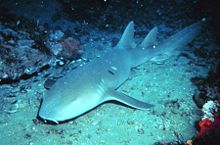
Chondrichthyes is a class of jawed fish that contains the cartilaginous fish or chondrichthyans, which all have skeletons primarily composed of cartilage. They can be contrasted with the Osteichthyes or bony fish, which have skeletons primarily composed of bone tissue. Chondrichthyes are aquatic vertebrates with paired fins, paired nares, placoid scales, conus arteriosus in the heart, and a lack of opercula and swim bladders. Within the infraphylum Gnathostomata, cartilaginous fishes are distinct from all other jawed vertebrates.

Carcharhiniformes, the ground sharks, are the largest order of sharks, with over 270 species. They include a number of common types, such as catsharks, swellsharks, and requiem sharks.

Scyliorhinus is a genus of catsharks in the family Scyliorhinidae. This genus is known in the fossil records from the Cretaceous period, late Albian age to the Pliocene epoch.
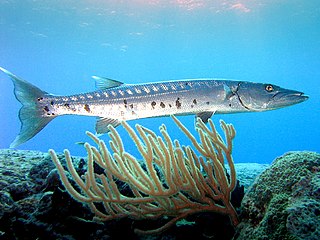
A barracuda is a large, predatory, ray-finned fish known for its fearsome appearance and ferocious behaviour. The barracuda is a saltwater fish of the genus Sphyraena, the only genus in the family Sphyraenidae, which was named by Constantine Samuel Rafinesque in 1815. It is found in tropical and subtropical oceans worldwide ranging from the eastern border of the Atlantic Ocean to the Red Sea, on its western border the Caribbean Sea, and in tropical areas of the Pacific Ocean. Barracudas reside near the top of the water and near coral reefs and sea grasses. Barracudas are targeted by sport-fishing enthusiasts.

Carpet sharks are sharks classified in the order Orectolobiformes. Sometimes the common name "carpet shark" is used interchangeably with "wobbegong", which is the common name of sharks in the family Orectolobidae. Carpet sharks have five gill slits, two spineless dorsal fins, and a small mouth that does not extend past the eyes. Many species have barbels.
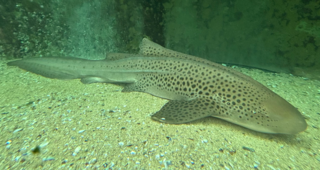
The zebra shark is a species of carpet shark and the sole member of the family Stegostomatidae. It is found throughout the tropical Indo-Pacific, frequenting coral reefs and sandy flats to a depth of 62 m (203 ft). Adult zebra sharks are distinctive in appearance, with five longitudinal ridges on a cylindrical body, a low caudal fin comprising nearly half the total length, and usually a pattern of dark spots on a pale background. Young zebra sharks under 50–90 cm (20–35 in) long have a completely different pattern, consisting of light vertical stripes on a brown background, and lack the ridges. This species attains a length of 2.5 m (8.2 ft).

The Ginglymostomatidae are a cosmopolitan family of carpet sharks known as nurse sharks, containing four species in three genera. Common in shallow, tropical and subtropical waters, these sharks are sluggish and docile bottom-dwellers. They are the most abundant species of shark found in shallow coastal waters. Nurse sharks typically attack humans only if directly threatened.
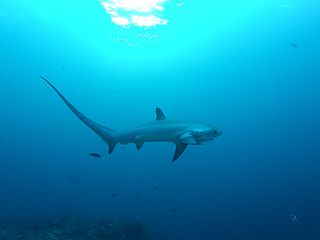
Thresher sharks are large mackerel sharks of the family Alopiidae found in all temperate and tropical oceans of the world; the family contains three extant species, all within the genus Alopias.

Squalicorax, commonly known as the crow shark, is a genus of extinct lamniform shark known to have lived during the Cretaceous period. The genus had a global distribution in the Late Cretaceous epoch. Multiple species within this genus are considered to be wastebasket taxon due to morphological similarities in the teeth.

The LVI Legislature of the Congress of the Union of Mexico met from 1994 to 1997.

The nurse shark is an elasmobranch fish in the family Ginglymostomatidae. The conservation status of the nurse shark is globally assessed as Vulnerable in the IUCN List of Threatened Species. They are considered to be a species of least concern in the United States and in The Bahamas, but considered to be near threatened in the western Atlantic Ocean because of their vulnerable status in South America and reported threats throughout many areas of Central America and the Caribbean. They are directly targeted in some fisheries and considered by-catch in others.

Myliobatis is a genus of eagle rays in the family Myliobatidae.

The tawny nurse shark is a species of carpet shark in the family Ginglymostomatidae, and the only extant member of the genus Nebrius.
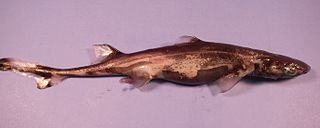
Etmopterus is a genus of lantern sharks in the squaliform family Etmopteridae. They are found in deep sea ecosystems of the Atlantic, Indian and Pacific Oceans.
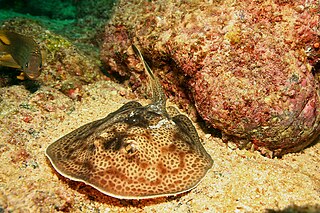
Urobatis is a genus of the family Urotrygonidae. These rays live in Costa Rica, Mexico, the Bahamas, El Salvador, Honduras, Guatemala, Nicaragua, Colombia, Venezuela, Panama, Trinidad and Tobago, Barbados, Grenada, Saint Vincent and the Grenadines, Saint Lucia, Martinique, Dominica, Guadeloupe, Montserrat, Antigua and Barbuda, Belize, Puerto Rico, Saint Kitts and Nevis, Anguilla, Dominican Republic, Haiti, Jamaica, Cuba, Cayman Islands, Virgin Islands, Turks and Caicos Islands, French Guiana, Guyana, Suriname, Chile, Peru, Ecuador and the United States.

Ginglymostoma unami, also known as the Pacific nurse shark is a nurse shark of the family Ginglymostomatidae. It is found in southeastern coast of Baja California, Mexico to Costa Rica including Gulf of California. It is 2.8 meters long. This species differs from Ginglymostoma cirratum between posterior end of the second dorsal fin and the beginning of the caudal lobe, both being shorter; the new species also differs by the position of the insertion of the first dorsal fin with regard to the pelvic fins and in the form and number of keels on the dermal denticles and teeth morphology. The Ginglymostoma unami was previously recognized as G.cirratum exhibiting a divided distribution of a species in the northern half of the Atlantic Ocean. However, that species is now considered to be restricted to just the Atlantic Ocean.
José Luis Castro Aguirre was a Mexican ichthyologist. He was a founding member of the Mexican Ichthyological Society and a member of the National System of Investigators who produced around 150 publications, focusing chiefly on the taxonomy, ecology, and biogeography of the fishes of Mexico. His 1978 book Catálogo sistemático de los peces marinos que penetran en aguas continentales de México, con aspectos zoogeográficos y ecológicos was the first catalog of estuarine fishes of Mexico. Born in Mexico City, he attended the National School of Biological Sciences at the National Polytechnic Institute (ENCB-IPN) earning a master's degree in 1974 and a PhD in 1986. He worked at the National Fisheries Institute and the Food and Agriculture Organization in the 1960s, and later was professor and researcher at the ENCB-IPN, Universidad Autónoma Metropolitana, the Interdisciplinary Center of Marine Science and Northeast Center of Biological Research. He described around a dozen fish species, including several species of shark. A book of research papers in his honor was produced in 2012, and he was posthumously commemorated in the names of the fish species Hypoplectrus castroaguirrei and Eugerres castroaguirrei.
Octouncuhaptor is a genus of monopisthocotylean monogeneans in the family Ancyrocephalidae.
